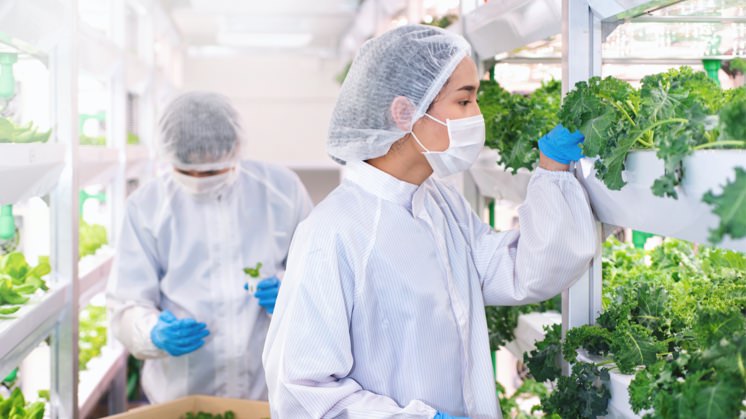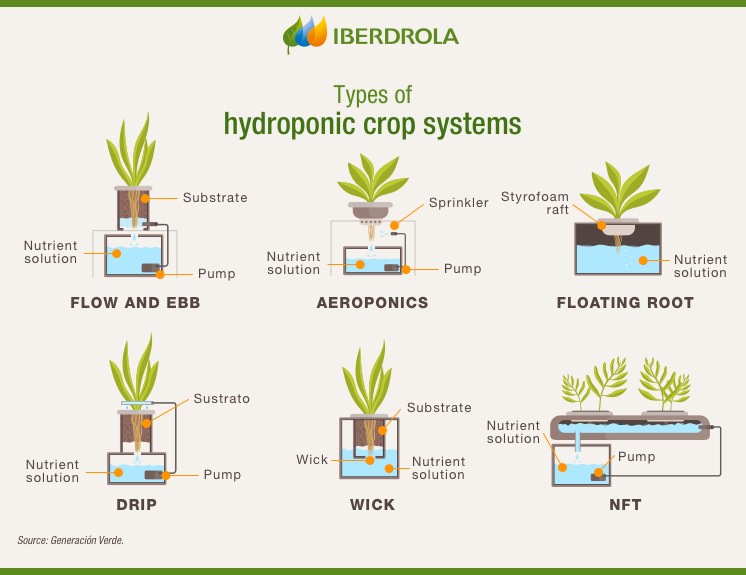What is hydroponics and advantages
Hydroponics, a crop technique allied to sustainability
Hydroponic crops are based on a practice that does away with soil and in its place uses a solution of water enriched with nutrients, among other alternatives. By using few resources, are seen as a option more sustainable solution than traditional agriculture. What's more, hydroponic crops can be grown at home!

Environmental conservation is one of the great challenges facing society and some of the current forms of agriculture pose a threat. In fact, the United Nations Food and Agriculture Organisation (FAO) presents it, along with other sectors, as one of the most common anthropogenic causes of soil pollution. Deforestation, caused largely by soil conservation for agricultural use, and the greenhouse effect emissions produced by the farms themselves bring the sustainability of the current model into question. However, there are alternatives such as hydroponics, a more sustainable form of cultivation that can be used in urban environments in order to be closer to consumers.
What is hydroponics
Hydroponics is a crop system that makes plants grow in a nutrient-rich water solution; in other words it does not use soil. Furthermore, the water used can be recovered and recycled, and the nutrients can be obtained from a variety of sources, including fish excrement (a technique known as aquaponics).
Growing plants in water without the need for soil is not new. The first mentions appear in a work by Francis Bacon published after his death (1627), Sylva Sylvarium. At the end of the 19th century, two German botanists (Julius von Sachs and Wilhelm Knop) described the list of elements that the solution had to contain to nourish the plants. Since then, it has been a form of cultivation commonly used in laboratories, but which in recent years has become important as a way to produce food with a higher yield and less use of land, water and energy.
Hydroponics and sustainable agriculture
Hydroponics is put forward as a solution to combat climate change, to reduce the environmental damage and species extinction caused by overexploitation and intensive farming. It also allows for a more rational use of water, an ever-scarcer resource. Hydroponic crops are also more profitable and easier to control, which turns them into a weapon to fight against hunger and to enhance food safety, especially in developing countries. According to the consultancy Berkshire Hathaway, the global hydroponics market is expected to grow to US$725 million by 2023, with a compound annual growth rate of 18.1 %.
Hydroponics is also one of the latest trends in smart farming, which consists of using technological tools, from geolocation to big data, artificial intelligence, the Internet of Things and drones to achieve greater yield from crops. The first vertical hydroponic farms, veritable skyscrapers dedicated to growing plants, are already being built in Droten (Holland), a country where soil and sun are scarce.
Characteristics of hydroponics (materials)
Traditional agriculture could be said to be an art, but hydroponics is a science in which all the elements that determine plant growth are controlled. We explain below:
 Nutrient solution
Nutrient solution
The composition of the nutrient solution requires sufficient concentrations of nitrogen, potassium, phosphorus, calcium, magnesium and sulphur, as well as other elements in smaller quantities. Many are obtained from salts, but they can also be supplemented or even substituted by organic fertilisers, such as cattle manure or bird guano. Other possible sources of nutrients are organic compounds such as fish-meal, wood or grain scraps, or seaweed.
 Substrates
Substrates
In hydroponic crops, the plants draw the nutrients from the solution, but they still need a support and the roots have to be sufficiently aerated. Some of the most widely-used substrates are:
- Perlite, pumice or vermiculite: very light and porous stones that retain water but allow air to circulate through the roots.
- Rice husk, wood fibre or wool: these break down slowly, but they are very efficient in keeping the roots aerated.
- Rock wool: this is obtained by melting basalt rock and obtaining filaments that form a kind of sponge that does not break down.
 Hydroponic technology
Hydroponic technology
A hydroponic crop requires more technology and precision than a conventional one. Some of the necessary instruments and equipment are:
- Conductivity meters: the electrical conductivity of the nutrient solution indicates the amount of dissolved nutrients and whether they need to be replenished.
- pH meters: it is essential to control the acidity of the solution and substrate, as the optimal level is different for each crop.
- Lighting: Sunlight, artificial light, or a combination of both can be used to maximise yield. In recent years the use of LED lights has increased due to their low consumption.
- Air control: in closed environments, the concentration of CO2 in the air can be increased to improve fertility.
Hydropronic crops and plant types
Almost any plant can be grown with hydroponics, but certain hydroponic plants work particularly well:
Greens: green beans, cauliflower, cabbage, celery, broccoli, lettuce, pea, leek, spinach.
Vegetables: carrot, beetroot, cucumber, aubergine, onion, pepper, radish, courgette, tomato.
Fruit: cantaloupe melon, strawberry, raspberry, blueberry, grape and even tree fruits such as lemon or apple using dwarf trees.
Aromatic plants: basil, coriander, mint, thyme, sage, tarragon, rosemary.
Advice for using hydroponics at home
Having a small hydroponic garden at home is relatively inexpensive and simple. We offer some tips to set up our own hydroponic urban garden:
- A plastic container is required about 30 cm deep, and a 10 cm tray that fits over it, with a drainage hole.
- An aquarium pump is placed in the bottom of the container, with the spout positioned to pump the water with nutrients into the upper tray.
- The plants are placed in small plastic containers on a substrate made of coconut fibre or rock wool.
- The container is filled with water with nutrients, which will have to be replaced every week or so.
- The entire unit is placed in a sunny place or under growth lamps.

 SEE INFOGRAPHIC: Types of hydroponic crop systems [PDF]
SEE INFOGRAPHIC: Types of hydroponic crop systems [PDF]
For the non-handyman, there are commercial home hydroponic systems of a wide range of prices. From small growers for aromatic herbs placed on the kitchen top, to larger units that consist of shelves with water pumps and lighting. Some are even controlled electronically via a mobile app.
Advantages and disadvantages of hydroponics
Some of the main benefits of hydroponics are:
- Higher yield: they produce between three and ten times more food than conventional agriculture in the same space. The plants also grow in half the time.
- There is no need for herbicides or pesticides: they are safe from weeds and insects, making unnecessaries the use of these products.
- Lower water consumption: it consumes 20 times less water than conventional agriculture, as the water is recirculated and reused.
- Less contamination: since it is a closed system, there is neither water contamination nor soil with the remains of fertilisers or pesticides.
- Adaptation to extreme conditions: it allows plants to be grown in harsh environments, with poor soils or extreme weather.
Hydroponics also has certain disadvantages:
- The initial cost of the hydroponic crop installation is higher than that of conventional agriculture.
- Micro-organisms, such as bacteria and moulds, can contaminate the water and cause diseases that attack the plants. Furthermore, without soil as a barrier, these diseases can spread rapidly to the entire system through the water.
- Constant control and monitoring is necessary, both of nutrient levels and the irrigation and lighting, with sensors and computer systems that require technical knowledge.




